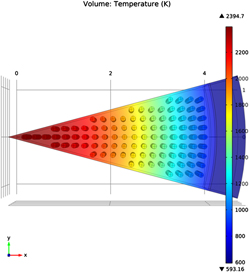Article contents
Impact of high porosity on thermal transport in UO2 nuclear fuel
Published online by Cambridge University Press: 03 June 2013
Abstract

During the advance of the nuclear fission reaction, fission products accumulate and form pores (gas bubbles) that decrease the thermal conductivity of the nuclear fuel, potentially leading to overheating of the fuel element. To investigate this important phenomenon, a finite-element method is used to simulate the effect of 3-dimensional (3D) distributions of pores on the thermal transport in a nuclear fuel element consisting of uranium oxide (UO2) nuclear fuel pellet and Zircaloy cladding. Spherical pores ranging in size from 70 to 172 µm are introduced to create up to 30 vol% total porosity. The simulations demonstrate that the centerline temperature increases with the total porosity and the increase is nonlinear. The results also show that the centerline temperature, at fixed total porosity, weakly depends on the pore size distribution. This method can provide useful information regarding the effect of high porosity levels that may occur in off-normal operation conditions.
- Type
- Articles
- Information
- Journal of Materials Research , Volume 28 , Issue 17: Focus Issue: Advances in the Synthesis, Characterization, and Properties of Bulk Porous Materials , 14 September 2013 , pp. 2308 - 2315
- Copyright
- Copyright © Materials Research Society 2013
References
REFERENCES
- 9
- Cited by


